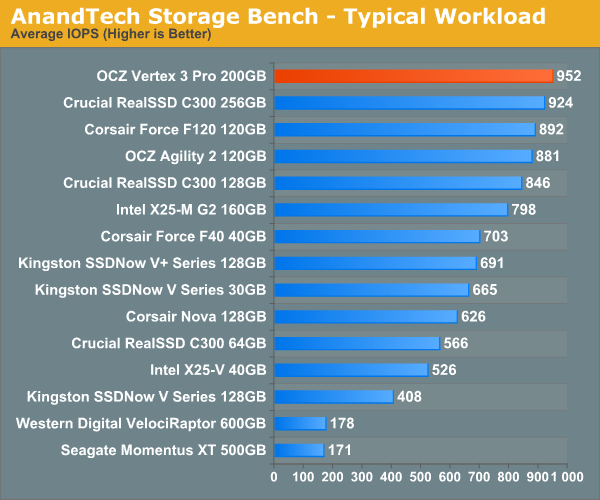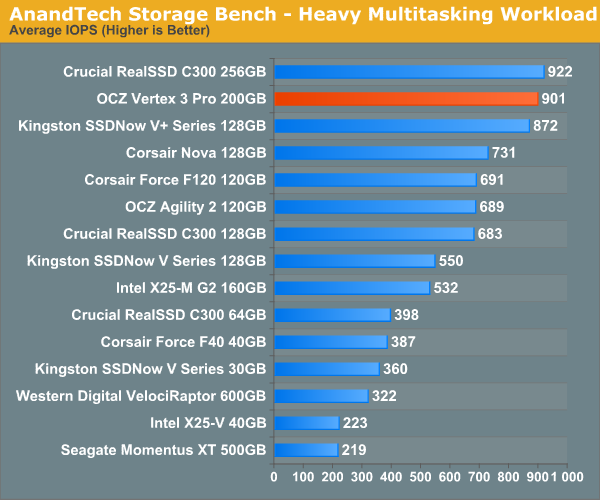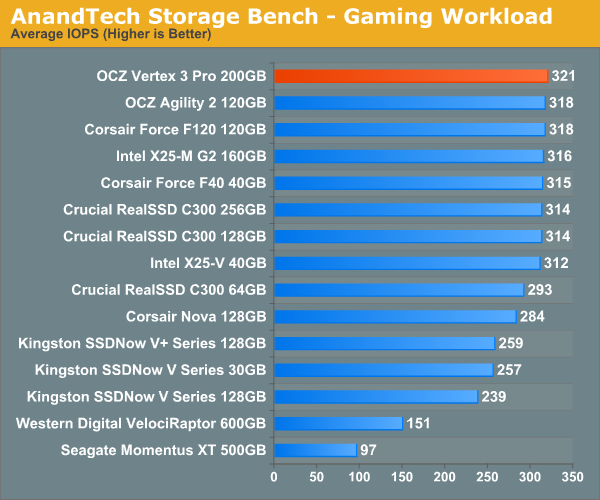OCZ Vertex 3 Pro Preview: The First SF-2500 SSD
by Anand Lal Shimpi on February 17, 2011 3:01 AM ESTAnandTech Storage Bench 2010
To keep things consistent we've also included our older Storage Bench. Note that the old storage test system doesn't have a SATA 6Gbps controller, so we only have one result for the Vertex 3 Pro (and the C300). The SF-2500 controller does respectably here, but with a 3Gbps controller we're only marginally faster than other SSDs (which is why we've moved to a new storage platform for 2011).
The first in our benchmark suite is a light/typical usage case. The Windows 7 system is loaded with Firefox, Office 2007 and Adobe Reader among other applications. With Firefox we browse web pages like Facebook, AnandTech, Digg and other sites. Outlook is also running and we use it to check emails, create and send a message with a PDF attachment. Adobe Reader is used to view some PDFs. Excel 2007 is used to create a spreadsheet, graphs and save the document. The same goes for Word 2007. We open and step through a presentation in PowerPoint 2007 received as an email attachment before saving it to the desktop. Finally we watch a bit of a Firefly episode in Windows Media Player 11.
There’s some level of multitasking going on here but it’s not unreasonable by any means. Generally the application tasks proceed linearly, with the exception of things like web browsing which may happen in between one of the other tasks.
The recording is played back on all of our drives here today. Remember that we’re isolating disk performance, all we’re doing is playing back every single disk access that happened in that ~5 minute period of usage. The light workload is composed of 37,501 reads and 20,268 writes. Over 30% of the IOs are 4KB, 11% are 16KB, 22% are 32KB and approximately 13% are 64KB in size. Less than 30% of the operations are absolutely sequential in nature. Average queue depth is 6.09 IOs.
The performance results are reported in average I/O Operations per Second (IOPS):

If there’s a light usage case there’s bound to be a heavy one. In this test we have Microsoft Security Essentials running in the background with real time virus scanning enabled. We also perform a quick scan in the middle of the test. Firefox, Outlook, Excel, Word and Powerpoint are all used the same as they were in the light test. We add Photoshop CS4 to the mix, opening a bunch of 12MP images, editing them, then saving them as highly compressed JPGs for web publishing. Windows 7’s picture viewer is used to view a bunch of pictures on the hard drive. We use 7-zip to create and extract .7z archives. Downloading is also prominently featured in our heavy test; we download large files from the Internet during portions of the benchmark, as well as use uTorrent to grab a couple of torrents. Some of the applications in use are installed during the benchmark, Windows updates are also installed. Towards the end of the test we launch World of Warcraft, play for a few minutes, then delete the folder. This test also takes into account all of the disk accesses that happen while the OS is booting.
The benchmark is 22 minutes long and it consists of 128,895 read operations and 72,411 write operations. Roughly 44% of all IOs were sequential. Approximately 30% of all accesses were 4KB in size, 12% were 16KB in size, 14% were 32KB and 20% were 64KB. Average queue depth was 3.59.

The gaming workload is made up of 75,206 read operations and only 4,592 write operations. Only 20% of the accesses are 4KB in size, nearly 40% are 64KB and 20% are 32KB. A whopping 69% of the IOs are sequential, meaning this is predominantly a sequential read benchmark. The average queue depth is 7.76 IOs.











144 Comments
View All Comments
Out of Box Experience - Tuesday, February 22, 2011 - link
Thanks for answering my questionand you are right
with over 50% of all PCs still running XP, it would indeed be stupid for the major SSD companies to overlook this important segment of the market
with their new SSDs ready to launch for Windows 7 machines, they should be releasing plug and play replacements for all the XP machines out there any day now..................NOT!
Are they stupid or what??
no conspiracy here folks
just the facts
Kjella - Thursday, February 24, 2011 - link
Fact: Most computers end their life with the same hardware they started with. Only a small DIY market actually upgrades their hard disk and migrates their OS/data. So what if 50% runs XP? 49% of those won't replace their HDD with an SSD anyway. They might get a new machine with an SSD though, and almost all new machines get Windows 7 now.Cow86 - Thursday, February 17, 2011 - link
Very interesting indeed....good article too. One has to wonder though - looking at what is currently happening with 25 nm NAND in vertex 2 drives, which have lower performance and reliability than their 34 nm brethren ánd are sold at the same price without any indication - how the normal Vertex 3 will fare...Hoping they'll be as good in that regard as the original vertex 2's, and I may well indeed jump on the SSD bandwagon this year :) Been holding off for lower price (and higher performance, if I can get it without a big price hike); I want 160 GB to be able to have all my games and OS on there.lecaf - Thursday, February 17, 2011 - link
Vertex 3 with 25 NAND will also suffer performance loss.It is not the NAND it self having the issue but the numbers of the chips. You get same capacity with half the chips, so the controller has less opportunity to write in parallel.
This is the same reason why with Crucial's C300 the larger (256) drive is faster than the smaller (128).
Speed will drop for smaller drivers but if price goes down this will be counterbalanced by larger capacity faster drives.
The "if" is very questionable of course considering that OCZ replaced NAND on current Vertex2 with no price cut (not even a change in part number; you just discover you get a slower drive after you mount it)
InsaneScientist - Thursday, February 17, 2011 - link
Except that there are already twice as many chips as there are channels (8 channels, 16 NAND chips - see pg 3 of the article), so halving the number of chips simply brings the channel to chip ratio down to 1:1, which is hardly a problem.It's when you have unused channels that things slow down.
lecaf - Thursday, February 17, 2011 - link
1:1 can be a problem... depending who is the bottleneck.If NAND speed saturates the channel bandwidth then I agree there is no issue, but if the channel has available bandwidth, it could use it to feed an extra NAND and speed up things.
But that's theory ... check benchmarks here:
http://www.storagereview.com/ocz_vertex_2_25nm_rev...
Chloiber - Thursday, February 17, 2011 - link
It's possible to use 25nm chips with the same capacity, as OCZ is trying to do right now with the 25nm replacements of the Vertex 2.Nentor - Thursday, February 17, 2011 - link
Why are they making these flash chips smaller if there are the lower performance and reliability problems?What is wrong with 34nm?
I can understand with cpu there are the benefits of less heat and such, but with the flash chips?
Zshazz - Thursday, February 17, 2011 - link
It's cheaper to produce. Less materials used and higher number of product output.semo - Thursday, February 17, 2011 - link
OCZ should spend less time sending out drives with no housing and work on correctly marketing and naming their 25nm Vertex 2 drives.http://forums.anandtech.com/showthread.php?t=21433...
How can OCZ get away with calling a 55GB drive "60GB" and then trying to bamboozle everyone with technicalities and SandForce marketing words and abbreviations is beyond me.
It wasn't too long when they were in hot water with their jmicron Core drives and now they're doing this?